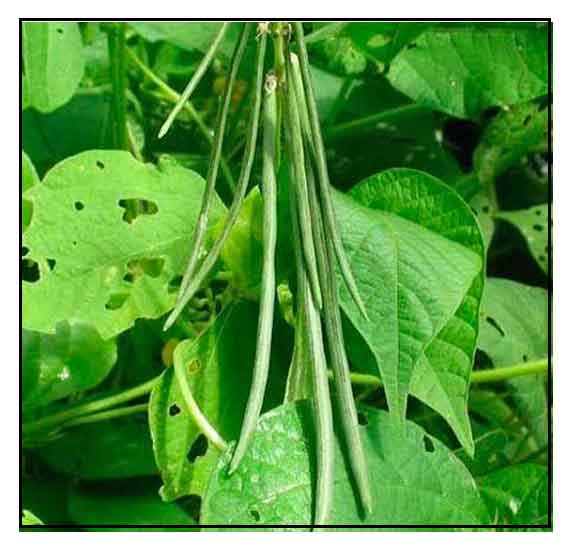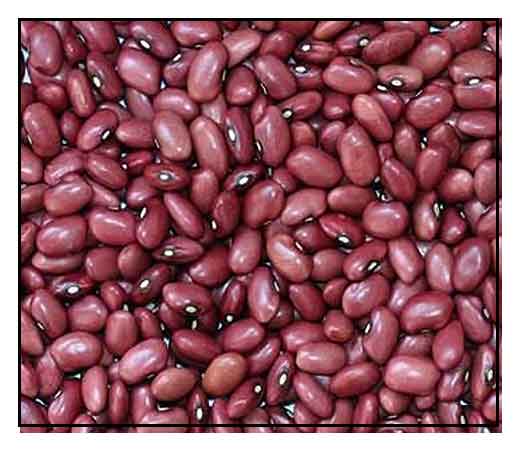 Botany Botany
Vigna umbellata is a warm-season short-lived annual vine legume, erect, semi-erect or twining, 30 to 100 cm in height, occasionally up to 200 cm, with an extensive root system and a taproot that can be as deep as 100-150 cm. Stems are branched and finely haired. Leaves are trifoliate with entire 6-9 cm long leaflets. Flowers are yellow and papillonaceous, borne on 5-10 cm long axillary racemes. Fruits are cylindrical, 7.5-12.5 cm long pods containing 6-10 oblong seeds. Seeds are 6-8 mm with a concave hilum. variable in color, from greenish-yellow to black or brown, but commonly red or yellow. (7)
Distribution
- Cultivated.
- Considered underutilized.
- Generally grown as intercrop with maize, on rice bunds or on terrace risers.
Constituents
- Composition of dried rice bean seeds per 100 g edible protein is: water 13.3 g, energy 1359 kJ or 327 kcal, protein 20.9 g, fat 0.9 g, carbohydrate 60.7 g, fiber 4.8 g, calcium 200 mg, phosphorus 390 mg, iron 10.9 mg, thiamin 0.49 mg, riboflavin 0.21 mg, niacin 2.4mg. (Leung, Busson & Jardin, 1968) (9)
-
Antinutritional factors include trypsin-inhibiting factors, phytates, tannins, and oligosaccharides. (Soaking, sprouting, hulling and cooking can reduce these antinutritional factors.) (9)
Properties
- Yellow-brownish seeds are considered most nutritious, while the red type provides common name in several languages.
- Rice beans are not easily processed into dhal because of its fibrous mucilage that prevents hulling and separation of cotyledons. (7)
- Considered galactagogue.
- Studies have suggested nutritional, antioxidant and antidiabetic properties.
Parts used
Seeds.
 Uses Uses
Edibility
- All varieties considered good sources of protein, essential amino acids, essential fatty acids and minerals. Dried seeds are added to cereal-based diet. (3)
- Often served as dal, soaked overnight and boiled with a few spices. Pulses are cooked or roasted as flour, to ground to make deep fried dishes or snacks. (3)
- Dry seeds are boiled and eaten with rice or replace rice in stews and soups. In Madagascar, they are ground to make a nutritive flour. (7)
- Young pods, leaves, and sprouted seeds are boiled and eaten as vegetable. Young pods sometimes eaten raw. (7)
Folkloric
- No folkloric medicinal use reported in the Philippines.
- Seeds used by lactating mothers.
Others
- Fodder: Valuable as high class fodder known to increase milk production in livestock. (3)
- Green manure / Cover crop:
Used as green manure crop; shown by field experiments as one of the best legumes for that purpose due to its high biomass production over a short period of time, easily incorporating into the soil and decomposing rapidly. (3) Grown for green manure, as cover crop, or as living fence or biological barrier. (7)
- Environmental: Rice bean is valuable for its ability to fix nitrogen in depleted soils and in mixed cropping with local varieties of maize; also beneficial in preventing soil erosion. (3)
Studies
• Antidiabetic / Antioxidant: Study evaluated the total phenolic content, antidiabetic, and antioxidant potential of 13 varieties of rice beans from China. Eight phenolic compounds were analyzed by U)PLC mass spectrometry i.e., catetchin, epicatechin, p-coumaric acid, ferulic acid, vitexin, isovitexin, sinapic acid and quercetin. Total phenolic compounds ranged from 123.09 to 843.75 µg/g. Antioxidant activity ranged from 39.87 to 46.40 µM TE/g. The α-glucosidase inhibition activity ranged from 44.32 to 68.71 and advanced glycation products formation inhibition activity ranged from 34.11 to 74.75. (5)
• Antioxidant / Seeds: Study evaluated methanolic extracts of raw and processed rice bean variety for bioactive compounds and antioxidant activity. The ME of seed coat showed highest phenolics (103.62 mg GAEg) and highest radical scavenging efficiency against DPPH (0.17 mg/ml). Results suggest a potential nutraceutical source from an exploited legume. (6)
• Nutritional Potential / Antioxidant: Study reports on rice bean as a legume with nutritional potential. It has higher nutritional quality as compared to other legumes in the Vigna family. This study evaluated for major nutritional constituents viz. proteins content, total lipids, dietary fiber, total carbohydrates, vitamins, minerals, amino acid and fatty acid profile. Fatty acid profile showed higher percentage of unsaturated fatty acids viz., linoleic and linolenic acid. Albumins and globulins were the major portion of proteins. (8)
• Rice Bean in the Formulation of Food Multi Mixes (FMM): Study for development of value added products like Food Multi-Mix from local ingredients for affordability, accessibility, and availability. FMM was developed using underutilized legume (Ricebean), millet (Konidhan) Fex seed, Rice, and tomato powder. Results showed FMM developed from malted ricebean with low levels of antinutritional factors and high nutritional composition can be used for development or incorporation of various value added products like cakes, cookies, etc. to enhance food and nutrient content. Vigna umbellata as a nutrient dense convenient product can be used by all age groups for supplemental or therapeutic uses including pregnancy, weaning, and community-based nutrition rehabilitation program for protein energy malnutrition in developing countries. (10)
Availability
Cultivated.
|

![]()



 Botany
Botany Uses
Uses